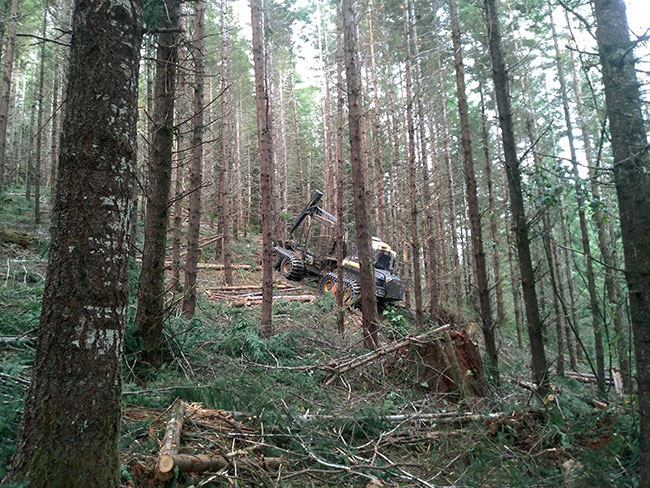
Features
Steep harvesting
Logging on steep slopes: a challenge or solution?
December 12, 2022 By Dzhamal Amishev
 Miller Timber Services winch-assist Ponsse forwarder at a second-growth Douglas-fir commercial thinning operation site near Corvallis, Ore. Photo courtesy Dzhamal Amishev.
Miller Timber Services winch-assist Ponsse forwarder at a second-growth Douglas-fir commercial thinning operation site near Corvallis, Ore. Photo courtesy Dzhamal Amishev. British Columbia’s forest sector is facing many difficulties – the declining timber supply, dwindling timber harvest land base, and the diminishing pool of skilled workers – and these challenges need to be overcome to increase the number of jobs from harvested trees in B.C.
The annual allowable cut (AAC) has been decreasing over the last 15 years due to mountain pine and spruce beetle infestations, as well as forest fires. Old-growth deferrals and new caribou habitat protection laws could further reduce AAC volumes province wide. One proposed solution to the problem is in the form of fire-damaged timber, estimated at 40 million cubic metres, as well as harvesting waste estimated at 1.2 million cubic metres.
Considering B.C.’s geography and topography, a large proportion of those proposed sources would be on steep and challenging terrain. That, as well as an already significant proportion of the harvest volumes located on steep slopes (slopes greater than 35 per cent), will most likely designate its oversized importance in the near future.
In 2017, FPInnovations’ Steep Slope Initiative researchers described the evolution of steep slope harvesting in Canada and the associated challenges (cost reduction, safety, skilled labour, regulatory compliance, investment in new equipment, fibre supply, and planning), proposed benefits of research on mechanization and technology implementation (worker safety, margin improvements, enhanced access to fibre, worker attraction and retention), and facilitated developments (equipment manufacturers, best practice guides and manuals, regulations). Challenges were significant and considerable research efforts were ongoing.
Five years later, there is no coherent international research effort on the topic and only piece-meal information is available on developments:
Winch-assist technology is well-established and implemented worldwide with an estimated 120 units in Canada, more than 200 in New Zealand, more than 300 in the U.S., in excess of 1,000 in South America (mainly Chile and Brazil), and more than 200 in Central Europe -(mainly Austria and Germany).
Utilized for all harvesting phases with felling and bunching (for subsequent yarder extraction) being the most common, followed by ground-based extraction (skidders and forwarders) and rarely for earthworks and access operations.
Some manufacturers are better positioned than others in terms of market share with the biggest growth in Chile, New Zealand, and the U.S.
Multiple best management practice documents have been developed and are freely available: general, harvester-specific, forwarder-specific, wire rope handling and inspection guide for machine operators, learning and training resources, inspection checklist for employers.
Productivity has been increasing over time due to improved machine design, targeted implementation, better planning and synchronization between harvesting phases, technology developments for equipment monitoring and analysis, etc.
Safety has been by far the biggest winner of winch-assist implementation compared to traditional hand-felling and cable extraction methods.
Proposed integrated approaches for production performance analysis of both winch-assist harvesting, as well as grapple yarding operations promise to enhance the monitoring and visibility of the fibre supply chain on steep slopes and in turn further improve planning, rate development, contractor attraction and retention, and reconciliation between inventory and operations.
Relatively recent developments in steep slope harvesting technology and techniques might be key to designate steep slope harvesting as a possible solution to the crisis. An extensive amount of efforts and investments is dedicated to commercial thinning operations both in B.C. and in the U.S.
A prominent and sought-after contractor, Miller Timber Services, has successfully specialized in steep slope thinning operations with more than 40 winch-assist cut-to-length units deployed all over the western U.S. And while such expertise and technology are needed and could be the answer from a wildfire prevention perspective south of the border, it could prove beneficial for the fibre supply crisis in Canada. Their training, planning, and execution expertise were demonstrated at the recent COFE-FORMEC-IUFRO conference field trip in Corvallis, Ore., last October.
Another development is the design and prototyping of remote-controlled unmanned winch-assist equipment that has the potential to provide a further improved access to steeper and more challenging terrain that would otherwise be inaccessible from an operator safety and regulations point of view. One such prototype is the patent pending winch-assist timber shuttle machine developed jointly between Austrian Ecoforst and Swiss Konrad companies, which was presented at the same conference.
Several studies from different countries investigate furthering this concept with the implementation of automation and robotics in forest operations, with the main efforts currently focused on the forwarding phase. Once commercialized, further reach and extended work hours could enhance productivity and help solve the timber supply challenge.
Ongoing efforts towards next generation training tools in the shape of games or simulator incorporated modules would also contribute to the attraction, training, and retention of the future workforce that would be needed to ultimately ensure the sustainability of the forest sector in Canada and worldwide.
Dzhamal Amishev is an assistant professor at Lakehead University in Thunder Bay, Ont. and has over 15 years of experience in forestry research, including improving safety, increasing efficiency and reducing costs of steep slope forest operations.
Print this page